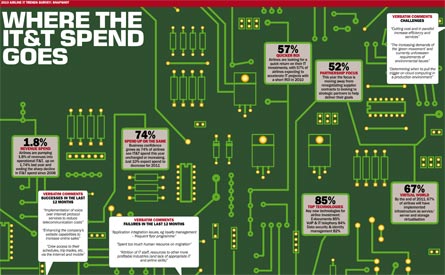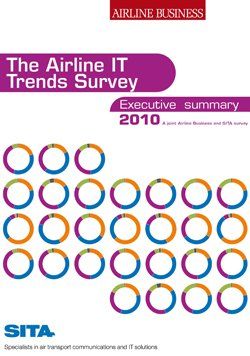As we emerge from one of the worst downturns in living memory, how is the harsh economic climate impacting IT investment plans? The benchmark Airline Business/SITA Airline IT Trends Survey offers some clues, writes Gillian Jenner
If you want to take the temperature of the airline industry, tracking the money being pumped into information technology and services is a good starting point. But to get the real story you have to dig into just how smartly chief information officers are spending that investment and where they are using IT to innovate.
Buffeted by global recession, fuel hikes and, most recently, volcanic ash clouds, these have been turbulent times for airlines. In such a demanding environment IT innovation can easily be consigned to the back burner, while a large part of the budget is drained on just treading water. However, the nimble-thinking airlines are emerging from recession leaner and more responsive to market change.
 |
|---|
Click here to see our graphic on the key IT spending trends |
The smart money is on enabling a multi-channel self-service environment for passengers, concentrating on web-based and mobile services. These airlines are keeping close tabs on their IT strategy to ensure it is absolutely aligned to the demands of the business, whether that is greater efficiency or preparing for growth.
EXECUTIVE SUMMARY |
|---|
 |
Download the executive summary of the Airline Business/SITA 2010 Airline IT Trends Survey here. |
But there are some important changes in strategy are underway. "In 2009 many airlines adopted short-term tactical measures, largely around deferment of IT projects or re-negotiating with suppliers," says Violante. "This year, airlines are looking to strengthen their relationships with IT providers and there is increased interest in IT outsourcing."
More IT projects are underway and in some regions there is a marked increase in activity. At Lufthansa Systems, executive board member Dr Gunter Küchler notes: "Whole markets have come back, then Russia came back. Projects started in 2008-09 came back in the first quarter of 2010, and at very high speed."
You would think the harsh economic realities of recent years would mean very little IT investment is wasted. However, some airlines are not working their IT spend hard enough to maximise the return. "In general there's too much money invested in rebuilding old systems. That means you don't use the new technology in the right way," says Küchler.
LEGACY MINDSET
The problem is people getting stuck in traditional thinking and behaviours. "IT is too focused on supporting existing processes and not changing processes, but it very much depends on the airline," adds Küchler.
Another big issue is that just keeping the lights on eats up a lot of the budget. "The airline industry has to spend quite a lot on IT just to keep running. When other industries look at IT, they look at innovation and doing things better. A lot of airlines are not able to spend as much on innovation," observes Ian Tunnacliffe, director of Travel Technology Research.
How investment plans are playing out very much depends on internal culture, with formal or bureaucratic airlines having a harder time with innovation and rapid response. Others, like Continental, foster a culture of employee empowerment to drive innovation.
"Our chief executive characterises us as 'an IT company with wings'," says Continental managing director for IT Services Bill Miller. "Our people respond with innovative ways to use technology. The programmers know if they can come up with a good idea it will be accepted. They don't have to come up with a submission to the board committee that will dissect it and look for all the things that will go wrong. We are probably more likely to put something out that is 85% correct put the functionality in place and correct it as we go down." In real terms, this means investment is concentrated on customer-facing technology and efficiency. Miller says IT investment is generally being targeted at self-service technologies and interline e-tickets. He adds: "We can accommodate all levels of codesharing and interline through check-in, automatic re-accommodation and many more applications surrounding and enhancing our legacy core."
Projects in development include a new passenger processing system and the company is working on ways to make the airline agents more efficient, helped by service-oriented architecture and graphical user interfaces.
The problem for Miller is not so much that the pace of change is too slow, rather it is so uneven. Leaving aside commercial elements, he says: "Each codeshare is a negotiation as to what technology functionality and capabilities are available and can be used."
WATCH THE WEBCAST |
|---|
Air Transport 2010 IT Summit: The next digital decade - watch the webcast here |
So, what does this mean for investment going forward? "There is likely to be a greater emphasis on investing in digital channels [e-commerce mobile technologies] and customer relationship management for both cost reduction and revenue growth, as well as business intelligence for improved business control and decision making," says Dawson.
Paul Coby, chief information officer at British Airways, has long advocated that there are no IT projects, only business projects. He asserts the airline should be spending money on "services and business change that give passengers things they want to pay for", although he also concedes that the industry still has some way to go before everyone shares his view.
BA is not ditching the lean approach to IT investment that has served it so well during the tough times. "[Last year] we managed to spend 16% less than we did the previous year. But we pretty much managed to deliver the same amount of technology," says Coby. "Broadly, what we are going to do in 2010-11 is we're holding our budgets at pretty much the same level, ie highly constrained."
Coby is keen on using agile development - breaking projects into small chunks of functionality that can be delivered quickly by small teams. Last year this agile approach was targeted at improving customer services and increasing revenues, delivering "millions of pounds in benefits". This year agile development will be used to enhance BA.com and the dynamic packaging BA Holidays area. "It feels to me to be a very different sort of year. We've still got the underlying imperative of cost savings, but being efficient. Also within that we need to be competitive in a market that is recovering and, as a global airline, we have to think of ways to serve our customers better."
IT bosses in airlines from Asia to Central America echo this view. Keeping the focus on the customer has helped Aeromexico weather some particularly tough breaks, "especially in Mexico last year because of H1NI flu, which practically shut down the airlines", says chief information officer Jaime Pocasangre. "What we did was to focus our investment on initiatives that have impact with our customers and have the potential to drive increases in revenue. That's why we invested in revamping our web pages and our frequent flyer platform. Now that things are progressing, we've decided we needed to expand."
Aeromexico's current priority is to invest in core transactional systems such as reservations, inventory and check-in, plus smaller related apps like revenue management. But Pocasangre is keen to ensure effort is invested in areas where his team can add value. So he is outsourcing revenue accounting processing, resulting in a head count reduction and savings to the company. Replacing this work, he is focusing internal resources into fraud prevention, accelerating the sales to cash cycle and revenue integration.
Japan's All Nippon Airways has targeted its innovation at initiatives like SKiP, which allows domestic passengers who have pre-paid and been assigned their seat, to skip check-in and go straight to security then the gate, using an ANA card or 2D bar code on a mobile for identification at security and boarding. "What we aim for with our IT is to lessen and simplify the steps of the customers in their boarding process," explains Naoaki Takayanagi, senior manager, consumer sales and marketing. "We would also like to seek further change in the processing of international operations as well, although these plans are not decided yet."
Singapore Airlines also sees technology as a useful tool to reach out to its customers and offer greater convenience, for example through online and mobile check-in. "Our strategy is to continually improve what is currently available to the end customers. This year we will be giving our website a new look and feel with the aim of making online transactions more user-friendly," says the airline.
Making the customer feel valued while generating additional revenue is at the heart of Air Canada's approach to IT investment and innovation. It is rolling out tools for passengers to buy a preferred seat or use a combination of frequent flyer points and cash to upgrade themselves from online and kiosk to lounges and boarding gates.
MOBILE MOVEMENT
Air Canada has been among the airlines vanguard in terms of mobile check-in and 2D boarding passes on mobiles, and it sees both web services and mobile as key technology areas for future investment. Chief information officer Lise Fournel is currently investigating starting a customer profile database and providing e-banking features to allow customers to download money onto their mobiles, which can be used to buy Air Canada products.
Fournel says the shift to web services is likely to enable her department to deliver technology to the airline in a shorter time frame, when compared with the legacy environment. "That helps us provide good services and translates into improved revenue and reduced costs," she says.
The key to investing smartly for Fournel is technologies that have a future. "The pace of change is very significant and we need to understand what will last and that's where you need to put your investment. We have got to make sure we're making the investment for trends that will be there in the long term and that's where we try to predict what the future will bring," she says. "We are making a lot of investment in mobile because we decided as an airline that will be part of the future."
It is this strategic focus that is creating a groundswell of confidence for airlines going forward. Says SITA's Violante: "Self-service and the internet are being exploited to the full and the industry has a clear road map as to how it will maximise these in the future."
Source: Airline Business



















